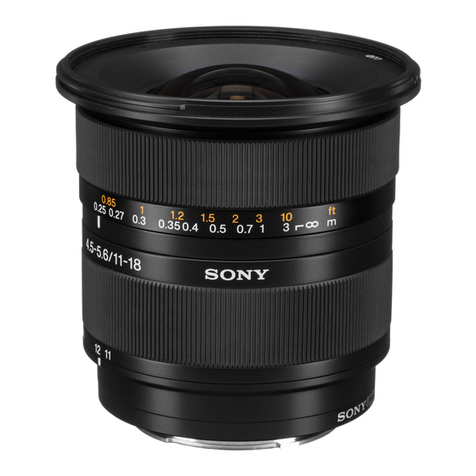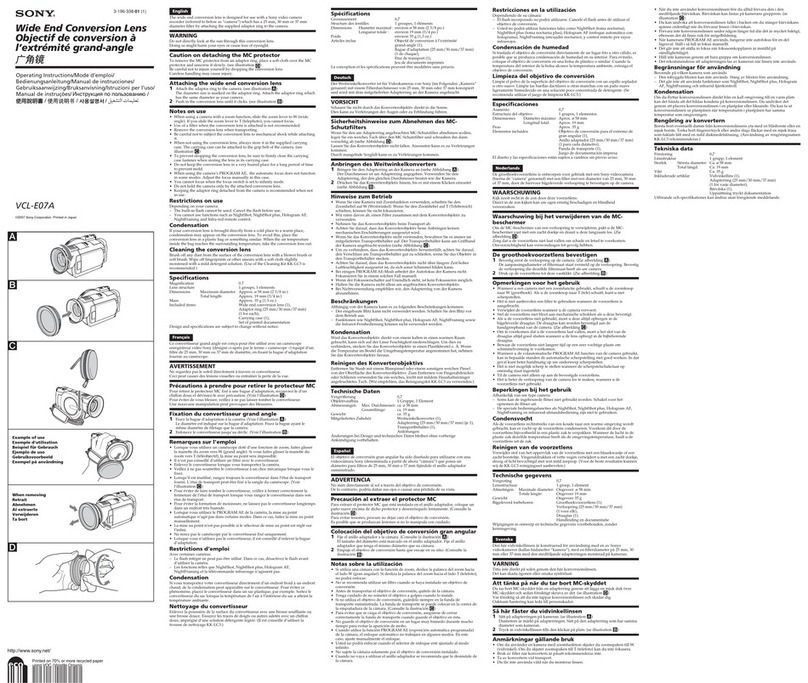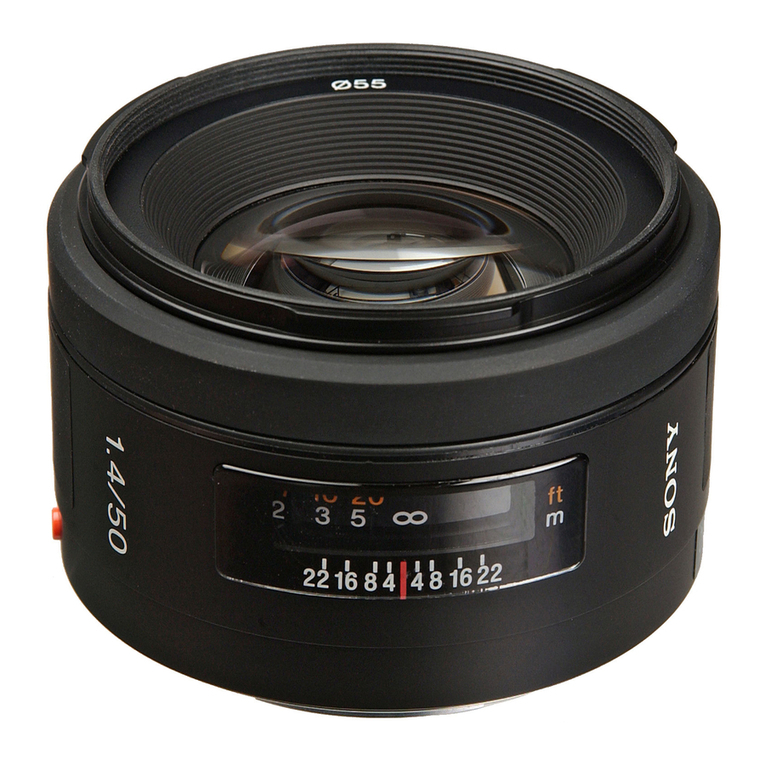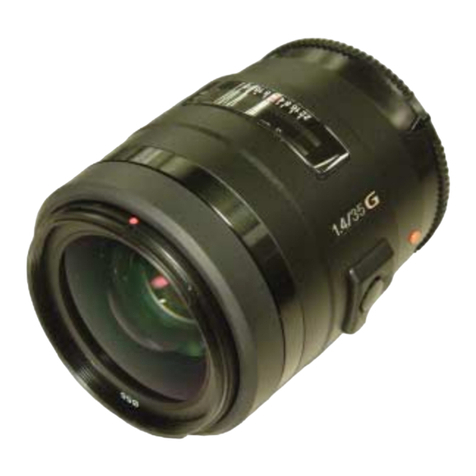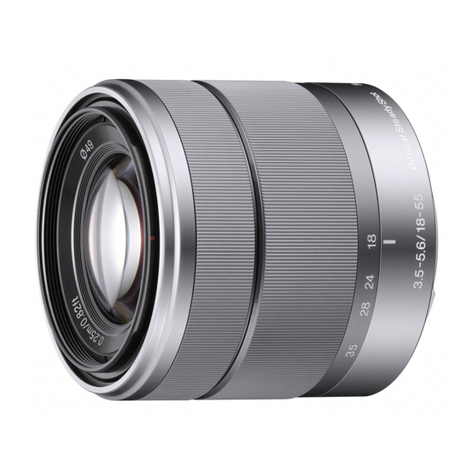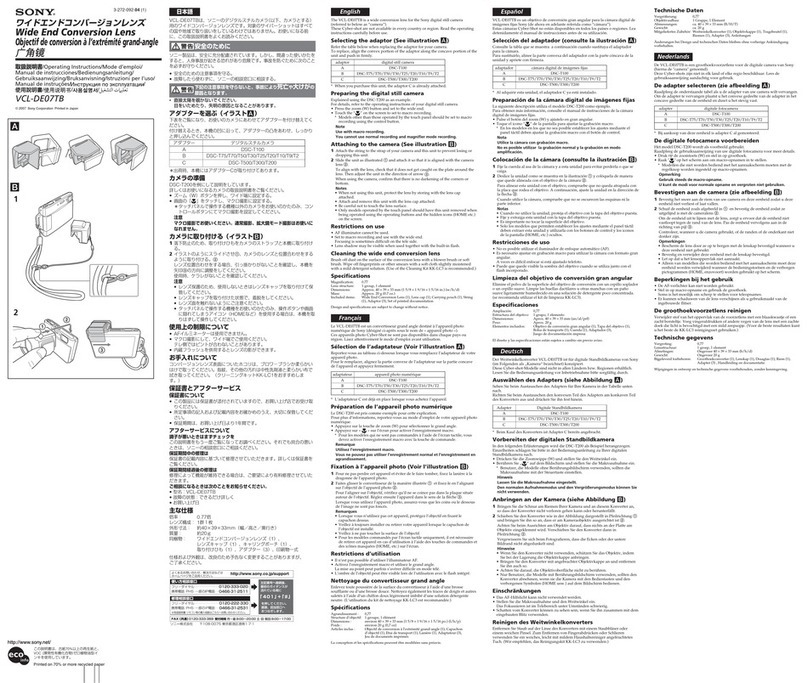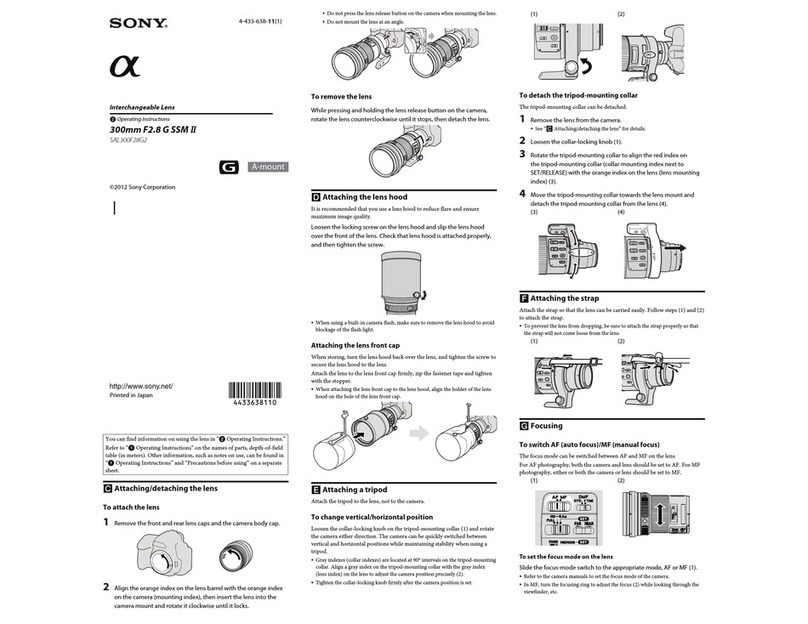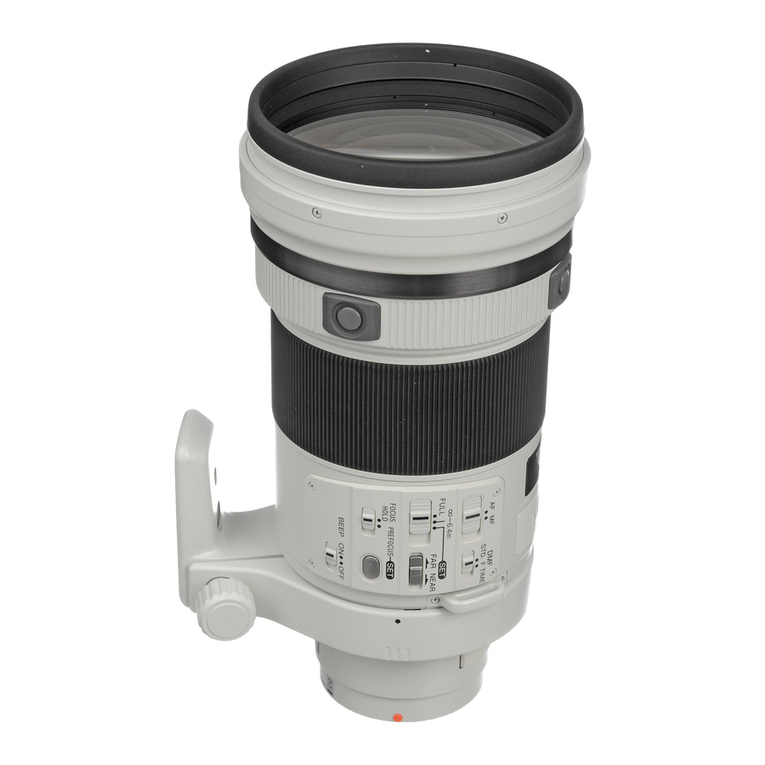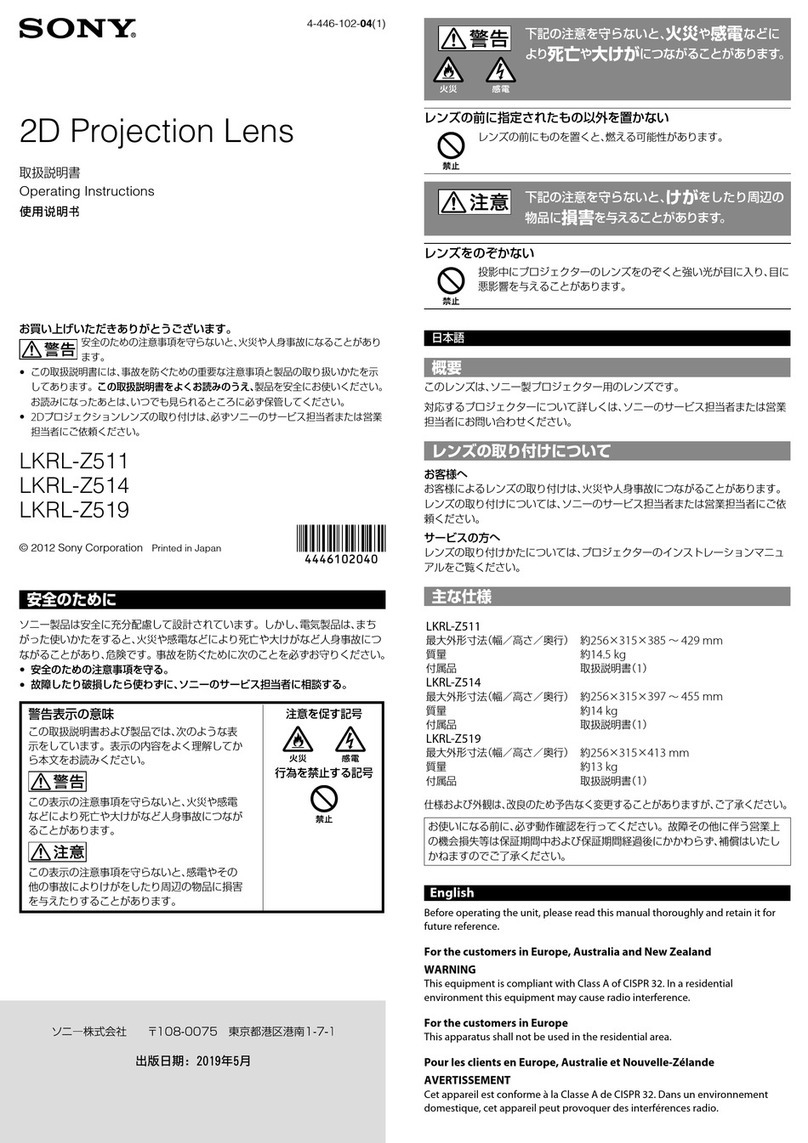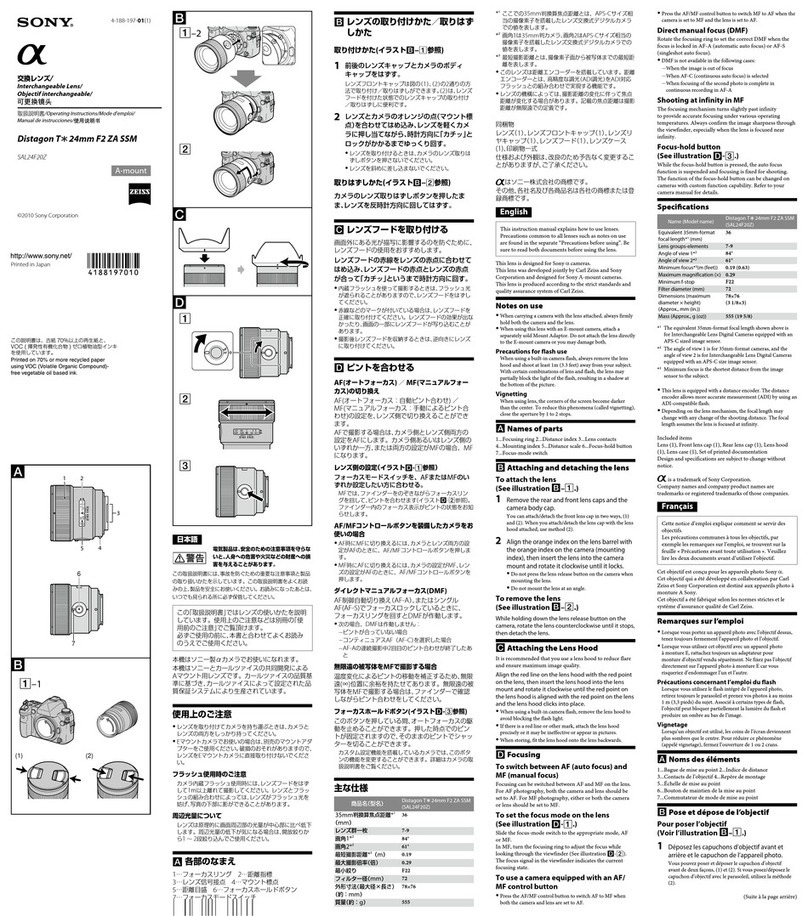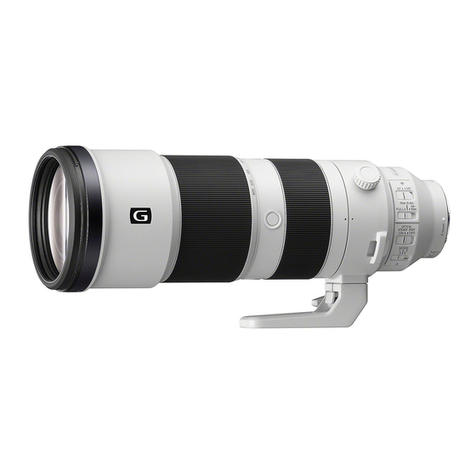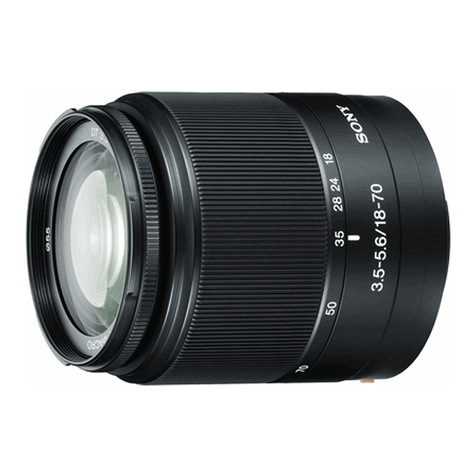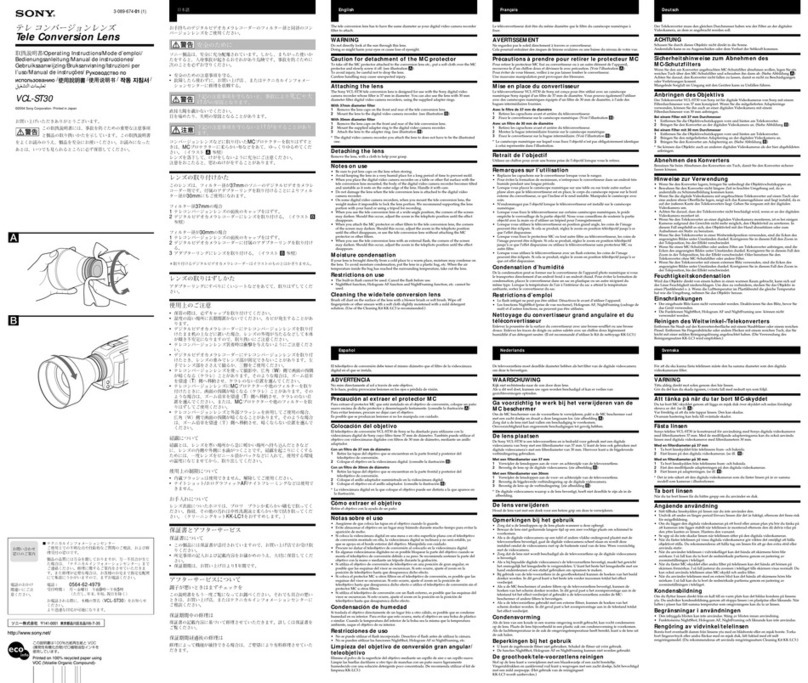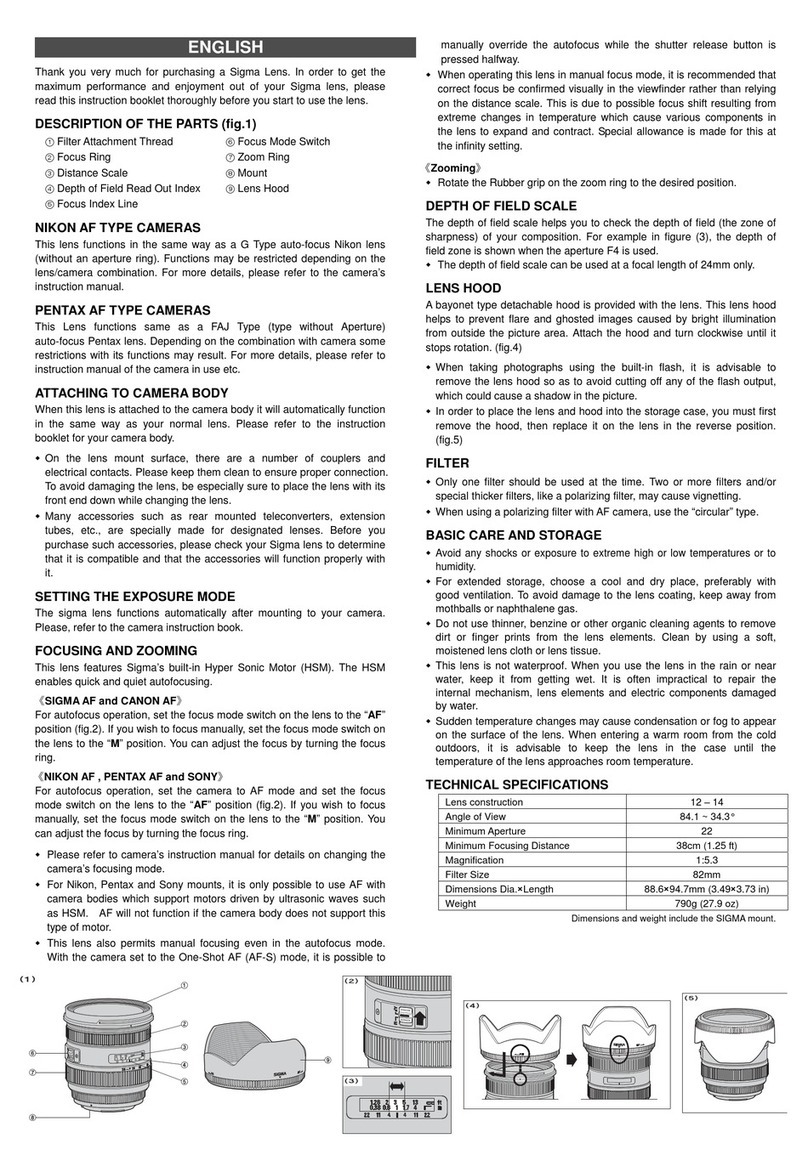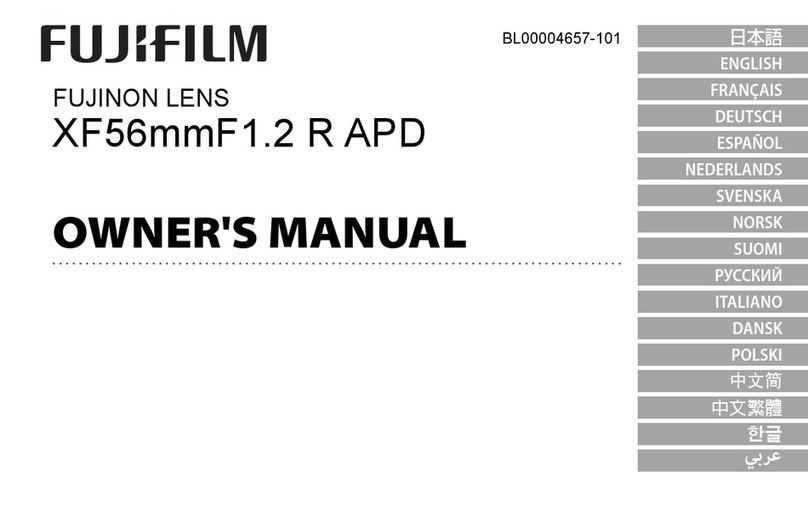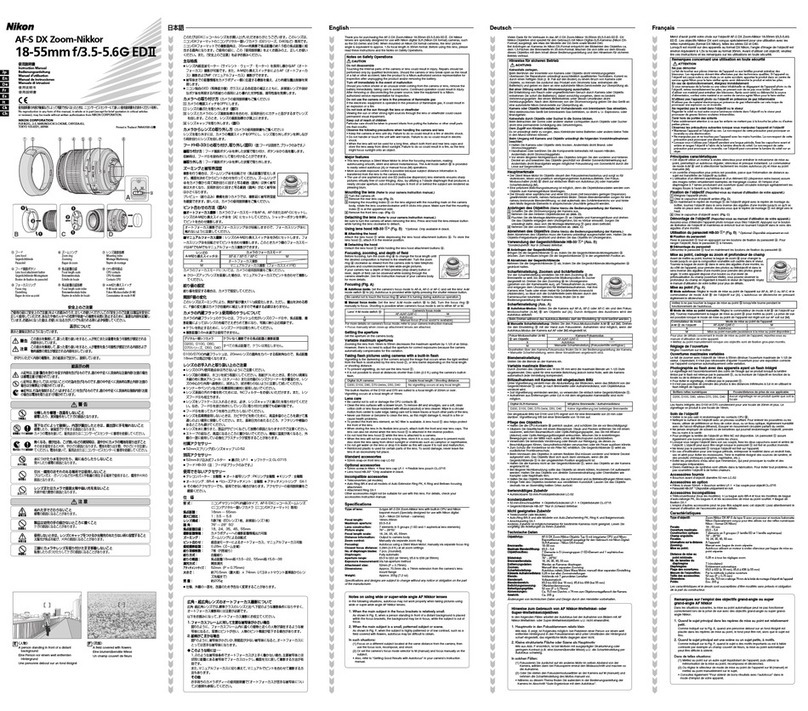電気製品は、安全のための注意事項を守ら
ないと、人身への危害や火災などの財産へ
の損害を与えることがあります。
この取扱説明書には、事故を防ぐための重要な注意事項と製品
の取り扱いかたを示しています。この取扱説明書をよくお読
みの上、製品を安全にお使いください。お読みになったあとは、
いつでも見られる所に必ず保管してください。
この「取扱説明書」ではレンズの使いかたを説明
しています。使用上のご注意など、レンズに共
通したご注意や説明については別冊の「使用前
のご注意」でご覧頂けます。
必ずご使用の前に、本書と合わせてよくお読み
のうえでご使用ください。
本機はソニー製αカメラシステムEマウントカメラ
専用のレンズです。Aマウントカメラにはお使いに
なれません。
使用上のご注意
レンズを取り付けてカメラを持ち運ぶときは、カメラと
レンズの両方をしっかり持ってください。
ズームにより繰り出されたレンズ部分でカメラを保持し
ないでください。
フラッシュ使用時のご注意
フラッシュ使用時には、1m以上離れて撮影してくださ
い。レンズとフラッシュの組み合わせによっては、レン
ズがフラッシュ光を妨げ、写真の下部に影ができること
があります。
周辺光量について
レンズは原理的に画面周辺部の光量が中心部に比べ低下
します。周辺光量の低下が気になる場合は、開放絞りか
ら1〜 2段絞り込んでご使用ください。
各部のなまえ
1 フード指標
2 ズームリング
3 焦点距離目盛
4 ズームロックスイッチ
5 焦点距離指標
6 フォーカスリング
7 レンズ信号接点*
8 マウント標点
* 直接手で触れないでください。
レンズの取り付けかた/取りはず
しかた
取り付けかた(イラスト–参照)
1 前後のレンズキャップとカメラのボディ
キャップをはずす。
レンズフロントキャップは図の(1)、(2)の2通りの方
法で取り付け/取りはずしができます。(2)は、レン
ズフードを付けた状態でのレンズキャップの取り付
け/取りはずしに便利です。
2 レンズとカメラの白の点(マウント標点)を
合わせてはめ込み、レンズを軽くカメラに押
し当てながら、時計方向に「カチッ」とロック
がかかるまでゆっくり回す。
レンズを取り付けるときは、カメラのレンズ取りは
ずしボタンを押さないでください。
レンズを斜めに差し込まないでください。
取りはずしかた(イラスト–参照)
カメラのレンズ取りはずしボタンを押したま
ま、レンズを反時計方向に回してはずす。
レンズフードを取り付ける
画面外にある光が描写に影響するのを防ぐために、
レンズフードの使用をおすすめします。
レンズフードの赤線をレンズの赤線に合わせて
はめ込み、レンズフードの赤点とレンズの赤線
が合って「カチッ」というまで時計方向に回す。
カメラ内蔵、もしくは同梱フラッシュを使って撮影する
ときは、フラッシュ光が遮られることがありますので、レ
ンズフードをはずしてください。
撮影後レンズフードを収納するときは、逆向きにレンズ
に取り付けてください。
ズームする
ズームリングを回して、希望の焦点距離(ズーム
の位置)に合わせる。
ズームロックスイッチについて
携帯時など、レンズの自重による鏡筒の伸長を防ぎ
ます。
レンズをW端に戻してからスイッチの設定してく
ださい。
スイッチを方向にスライドさせロックします。
解除するにはスイッチを元の位置に戻します。
ピントを合わせる
ピント合わせは、以下3つの設定方法があります。
・オートフォーカス
ピント合わせを自動で行う。
・DMF(ダイレクトマニュアルフォーカス)
オートフォーカスでピントを合わせた後に、マニュ
アルでピントを微調整する。
・マニュアルフォーカス
ピント合わせを手動で行う。
各モードの設定方法は、カメラの取扱説明書をご覧
ください。
本レンズはピント合わせ動作の過程において画角
が小刻みに変化することがあります。AFモードコ
ンティニュアス(AF-C)の場合(シーンセレクショ
ン機能スポーツの場合を含む)に目立つことがあ
りますが、実際の撮影画像に影響はありません。
主な仕様
商品名
(型名)
E18-200mm F3.5-6.3 OSS LE
(SEL18200LE)
35mm判換算焦点距離*1
(mm)
27-300
レンズ群一枚 13-17
画角*176°-8°
最短撮影距離*2(m) 0.5
最大撮影倍率(倍)0.27
最小絞り f/22-f/40
フィルター径(mm) 62
外形寸法(最大径×長さ)
(約:mm)
68×97.1
質量(約:g) 460
補正効果段数*3約4段
*1ここでの35mm判換算焦点距離と画角は、APS-Cサイ
ズ相当の撮像素子を搭載したレンズ交換式デジタルカ
メラでの値を表します。
*2最短撮影距離とは、撮像素子面から被写体までの最短距
離を表します。
*3シャッタースピード(撮影条件により異なる)
レンズの機構によっては、撮影距離の変化に伴って焦点
距離が変化する場合があります。記載の焦点距離は撮影
距離が無限遠での定義です。
同梱物
レンズ(1)、レンズフロントキャップ(1)、
レンズリヤキャップ(1)、レンズフード(1)、
印刷物一式
仕様および外観は、改良のため予告なく変更するこ
とがありますが、ご了承ください。
はソニー株式会社の商標です。
This instruction manual explains how to use lenses.
Precautions common to all lenses such as notes on use
are found in the separate “Precautions before using”.
Be sure to read both documents before using your lens.
This lens is designed for Sony α camera system E-mount
cameras. You cannot use it on A-mount cameras.
Notes on Use
When carrying a camera with the lens attached, always firmly
hold both the camera and the lens.
Do not hold by the part of the lens that protrudes when
zooming.
Precautions on using a flash
When using a flash, shoot at least 1m (3.3 feet) away from
your subject. With certain combinations of lens and flash, the
lens may partially block the light of the flash, resulting in a
shadow at the bottom of the picture.
Vignetting
When using the lens, the corners of the screen become darker
than the center. To reduce this phenomena (called vignetting),
close the aperture by 1 to 2 stops.
Identifying the Parts
1 Hood index
2 Zooming ring
3 Focal-length scale
4 Zoom lock switch
5 Focal-length index
6 Focusing ring
7 Lens contacts*
8 Mounting index
* Do not touch the lens contacts.
Attaching and Detaching the Lens
To attach the lens
(See illustration –.)
1
R
emove the rear and front lens caps and
the camera body cap.
You can attach/detach the front lens cap in two ways, (1)
and (2). When you attach/detach the lens cap with the
lens hood attached, use method (2).
2Align the white index on the lens barrel
with the white index on the camera
(mounting index), then insert the lens into
the camera mount and rotate it clockwise
until it locks.
Do not press the lens release button on the camera when
mounting the lens.
Do not mount the lens at an angle.
To remove the lens
(See illustration –.)
While holding down the lens release button on
the camera, rotate the lens counterclockwise
until it stops, then detach the lens.
Attaching the Lens Hood
It is recommended that you use a lens hood to reduce flare
and ensure maximum image quality.
Align the red line on the lens hood with the
red line on the lens (hood index), then insert
the lens hood into the lens mount and rotate it
clockwise until the red point on the lens hood
is aligned with the red line on the lens (hood
index) and the lens hood clicks into place.
When using a built-in camera flash or a flash supplied with the
camera, remove the lens hood to avoid blocking the flash light.
When storing, fit the lens hood onto the lens backwards.
Zooming
Rotate the zooming ring to the desired focal
length.
Zoom lock switch
This prevents the lens barrel from extending due to the
weight of the lens while it is being carried.
Before setting the zoom lock switch, fully return the lens
to W (wide).
Slide the zoom lock switch in the direction to lock the
zoom. To unlock the zoom, slide the zoom lock switch
back.
Focusing
There are three ways to focus.
• Auto focus
The camera focuses automatically.
• DMF (Direct manual focus)
After the camera focuses in auto focus, you can make a
fine adjustment manually.
• Manual focus
You focus manually.
For details on mode settings, refer to the instruction
manual supplied with the camera.
The angle of view may change slightly as you focus with
this lens. This change in angle of view may be more
evident when the camera is set to “Continuous” in AF
mode (AF-C) (including “Sports Action” in the Scene
Selection function). This does not affect the actual
recorded images.
Specifications
Product name
(Model name)
E18-200mm F3.5-6.3 OSS LE
(SEL18200LE)
Equivalent 35mm-format
focal length*1(mm)
27-300
Lens groups-elements 13-17
Angle of view*176°-8°
Minimum focus*2(m (feet)) 0.5 (1.64)
Maximum magnification (X) 0.27
Minimum f-stop f/22-f/40
Filter diameter (mm) 62
Dimensions (maximum
diameter × height)
(approx., mm (in.))
68×97.1
(2 5/8×3 7/8)
Mass (approx., g (oz)) 460 (16.2)
Compensation effect *3Approx. 4 steps
*1The values shown above for equivalent 35mm-format
focal length and angle of view are for Interchangeable Lens
Cameras equipped with an APS-C sized image sensor.
*2Minimum focus is the shortest distance from the image
sensor to the subject.
*3Shutter speed (differs with shooting conditions)
Depending on the lens mechanism, the focal length may
change with any change in shooting distance. The focal
lengths given above assume the lens is focused at infinity.
4-428-971-02(1)
©2012 Sony Corporation
SEL18200LE
交換レンズ
Interchangeable Lens
Objectif interchangeable
取扱説明書
Operating Instructions
Mode d’emploi
Manual de instrucciones
E 18-200mm F3.5-6.3 OSS LE
E-mount
Printed in China
Included items
Lens (1), Front lens cap (1), Rear lens cap (1),
Lens hood (1), Set of printed documentation
Design and specifications are subject to change without
notice.
is a trademark of Sony Corporation.
Cette notice explique comment se servir des objectifs.
Les précautions communes à tous les objectifs, par
exemple les remarques sur l’emploi, se trouvent sur la
feuille « Précautions avant toute utilisation ». Veuillez
lire les deux documents avant d’utiliser votre objectif.
Votre objectif est conçu pour les appareils photo à
monture E de type Sony α. Il ne peut pas être utilisé pour
les appareils photo à monture A.
Remarques sur l’emploi
Lorsque vous portez un appareil photo avec l’objectif dessus,
tenez toujours fermement l’appareil photo et l’objectif.
Ne tenez pas l’appareil photo par la partie de l’objectif qui
ressort lors d’un zoom.
Précautions concernant l’emploi d’un flash
Si vous utilisez un flash, prenez la photo à au moins 1 m (3,3
pieds) du sujet. Associé à certains types de flash, l’objectif
peut bloquer partiellement la lumière du flash et produire un
ombre au bas de l’image.
Vignetage
Lorsque l’objectif est utilisé, les coins de l’écran deviennent
plus sombres que le centre. Pour réduire ce phénomène
(appelé vignetage), fermez l’ouverture de 1 ou 2 crans.
Identification des éléments
1 Repère de parasoleil
2 Bague de zoom
3 Échelle de focale
4 Bouton de blocage de zoom
5 Repère de focale
6 Bague de mise au point
7 Contacts de l’objectif*
8 Repère de montage
* Ne touchez pas les contacts d’objectif.
Pose et dépose de l’objectif
Pour poser l’objectif
(Voir l’illustration –.)
1Déposez les capuchons d’objectif avant et
arrière et le capuchon de l’appareil photo.
Vous pouvez poser et déposer les capuchons d’objectif
avant de deux façons, (1) et (2). Si vous posez/déposez le
capuchon d’objectif avec le parasoleil, utilisez la méthode
(2).
2Alignez le repère blanc du barillet
d’objectif sur le repère blanc de l’appareil
photo (repère de montage), puis posez
l’objectif sur la monture de l’appareil photo
et tournez-le dans le sens horaire de sorte
qu’il s’encliquette.
N’appuyez pas sur le bouton de libération de l’objectif sur
l’appareil photo lorsque vous posez l’objectif.
Ne posez pas l’objectif de biais.
Pour déposer l’objectif
(Voir l’illustration –.)
Tout en appuyant sur le bouton de libération
de l’objectif sur l’appareil photo, tournez
l’objectif dans le sens antihoraire jusqu’à
l’arrêt, puis déposez l’objectif.
Fixation du parasoleil
Il est conseillé d’utiliser un parasoleil pour réduire la
lumière parasite et obtenir la meilleure image possible.
Alignez la ligne rouge du parasoleil sur la ligne
rouge de l’objectif (repère de parasoleil), puis
insérez le parasoleil sur la monture d’objectif
et tournez-le dans le sens horaire jusqu’à ce
que le point rouge du parasoleil s’aligne sur la
ligne rouge de l’objectif (repère de parasoleil)
et que le parasoleil s’encliquette.
Lorsque vous utilisez le flash intégré d’un appareil photo ou le
flash fourni avec un appareil photo, retirez le parasoleil pour
éviter de bloquer la lumière du flash.
Pour ranger le parasoleil, insérez-le à l’arrière de l’objectif.
Zooming
Tournez la bague de zoom selon la focale
souhaitée.
Bouton de blocage de zoom
Ce bouton empêche le barillet de l’objectif de se déployer
en raison de son poids lorsqu’il est transporté.
Avant de bloquer le zoom, revenez à la position extrême W
(grand angle) de l’objectif.
Faites glisser le bouton de blocage de zoom dans la
direction pour bloquer le zoom. Pour débloquer le
zoom, remettez le bouton de zoom dans sa position
d’origine.
(Suite à la page arrière)


